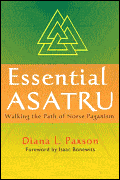
When it comes to north European religions, there really isn't much to them in terms of practice: boasting, toasting, and a whole lot of long-winded storytelling. Paxon does an admirable job conveying in her book Essential Asatru that this hard-drinking religion has more to it than mead horns: every aspect of its history can be directly related to modern life, and through storytelling devices she brings to light a religion that real people with real families live. She even adds the very real element of recovering alcoholics, environmental activists, and family struggle to this basic introduction, making this introduction to religion about the people that practice it, rather than about the abstract ideas embraced.
Asatru is made up of a diversity of northern cultures and a dichotomy of worldviews. Paxon examines these differences and similarities through the lens of individual practice, narrowing in on one theoretical person or family who practices the faith from the point of view of its history or precepts. She covers such complicated issues as sacrifice, racial division, and privacy with a light touch that allows Essential Asatru to be readable without once patronizing the audience. True to any piece of Heathen scholarship, her notes are detailed and her text allows for different schools of thought on the interpretations of historical happenings. She also incorporates well the way old-school heathens adapt to modern life, from the school teacher to the environmentalist.
This mainstreamed book on Asatru is a welcome change of pace from the usual Wiccan fare. It doesn't offer the spells and rituals summoned up for books classified under the New Age genre, but instead offers a thorough grounding in both history and the present, and shows how those values – the true heart of any religion – are expressed in the lives of its faithful. Even the approaches to the gods have a different flavor to them than their Wiccan counterparts; there is no worship here, no mystification. The gods are treated as heroes, and as conceivably flawed historical personages – people that deserve remembrance, flaws and all, and flaws that demand a consciousness of approach when engaging gods of far northern pantheons.
Paxon leaves the impression that Heathens are possibly more private people than their fellow Pagan religionists. This does seem to be true; Heathens in the Minnesota area tend to meld into the local population, and only come to moots and other meetings if and only if they know for certain of at least one person who shares their particular set of values. The reasoning for this is vague; there is an impression "between the lines" of the text that the perceived risks of being "out" are much greater than the actual risks.
Paxon is clearly knowledgeable on modern Heathenry from the inside, and she believes strongly in the values put forth under the Ring of Troth. Even so, she spare readers the usual "how to be heathen" fare, allowing them to read her words, consider their values, and decide for themselves whether or not to take up the axe. This book is recommended not just for personal education, but library shelves and world religion classes.
~review by Diana Rajchel
Author: Diana L. Paxson
Citadel Press, 2006
$12.95, pp. 204
